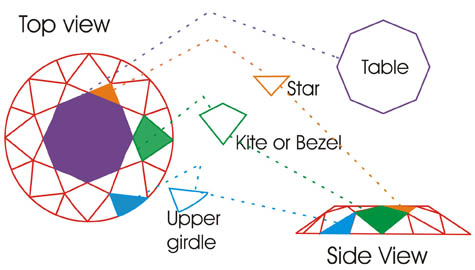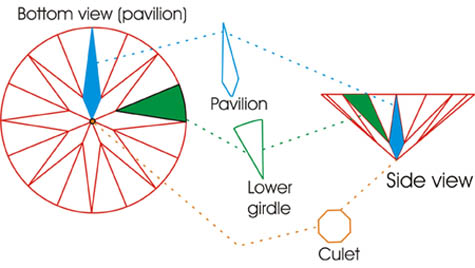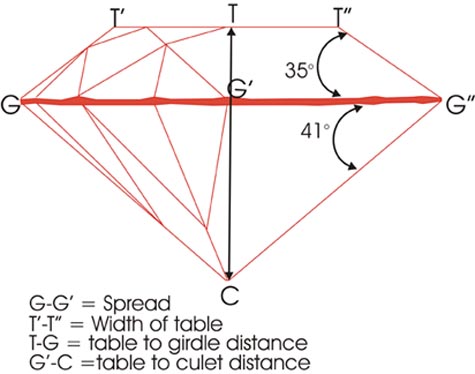
The lower portion of a diamond is called the Pavilion. It has 25 facets, 1 Culet, 8 Pavilion, and 16 Lower Girdle facets.

The culet is usually flattened but occasionally a point is left.
Diamond is so hard, that only a diamond can cut or polish a diamond. But diamond also has cleavage and this allows a stone to be cleaved along planes of weakness that follow certain direction in the crystal structure. Cleaving a stone is a rapid way to reduce a large stone into pieces that are easier to cut. Though it is possible to saw diamonds, cleaving them may reduce stress on a large stone that could be problematic in sawing.
The cut of a diamond is reported as shape (round, marquise, etc.), and make (the quality of the cut). The shape of a cut stone is determined by several factors The original shape and dimensions of the stone, the presence of inclusions or other imperfections, and lastly by the desire of the manufacturer. The make or quality of the cut is determined by the precision of the cutting (its symmetry and proportions) and by the degree of polish.
There are several major diamond shapes, Round (Brilliant Cut), Oval, Marquise, Emerald Cut, Princess Cut, Pear, Radiant, and Heart as well as smaller cuts and stones that are cut for supporting roles (For instance, Baguette Cut and Rose Cut).
The most important diamond shape is the Round or Brilliant Cut. This
has a total of 58 facets. The upper portion of the cut diamond is called
the Crown, it has a total of 33 facets, 1 Table facet, 8 Star facets, 8
Kite (or Upper Main Facets), 16 Upper Girdle facets. 
The lower portion of a diamond is called the Pavilion. It has 25 facets,
1 Culet, 8 Pavilion, and 16 Lower Girdle facets. 
The culet is usually flattened but occasionally a point is left.
If a stone is perfectly proportioned to bring out the most brilliance
and fire, it is called an ideal cut. The angles of an ideal cut are such
that as much possible light entering the stone leaves through the crown.
Special devices called hearts and arrow or proportion scopes can be used
to optically check the stone to see if it is ideally cut. The proportions
of an ideal cut are given below (You should be aware that none of illustrations
presented here are proportionally accurate). Stones that are improperly
cut are not as brilliant and are worth somewhat less than ideal cut stone.
Sometimes stones are intentionally cut with less than ideal proportions
to cheat a customer. If a stone is cut with too large a table so that the
depth from the table to the girdle is too thin, the stone is called a swindle.
A swindle looks larger than it actually is, but because the proportions
of the cut are changed to create extra spread, significant brilliancy is
lost. 
On a well-proportioned stone, the table to culet distance (T-C) is
about 60% of the girdle spread (G-G'). The height of table above the girdle
may vary from 33-50% of the distance G'-C (culet to girdle length), and
the table width T-T" should be between 40-60% of the spreadm G-G'. The
exact proportions vary somewhat, and these measurement should not too stringently
adhered to. Rather than trying to memorize the details of the cut, it is
best to compare several stones under similar lighting conditions and choose
what seems best. Stone that are poorly cut will become apparent with a
little experience. The smaller the stone, the more likely that the cut
will vary from ideal proportions. Very small stones have fewer facets and
less brilliance.